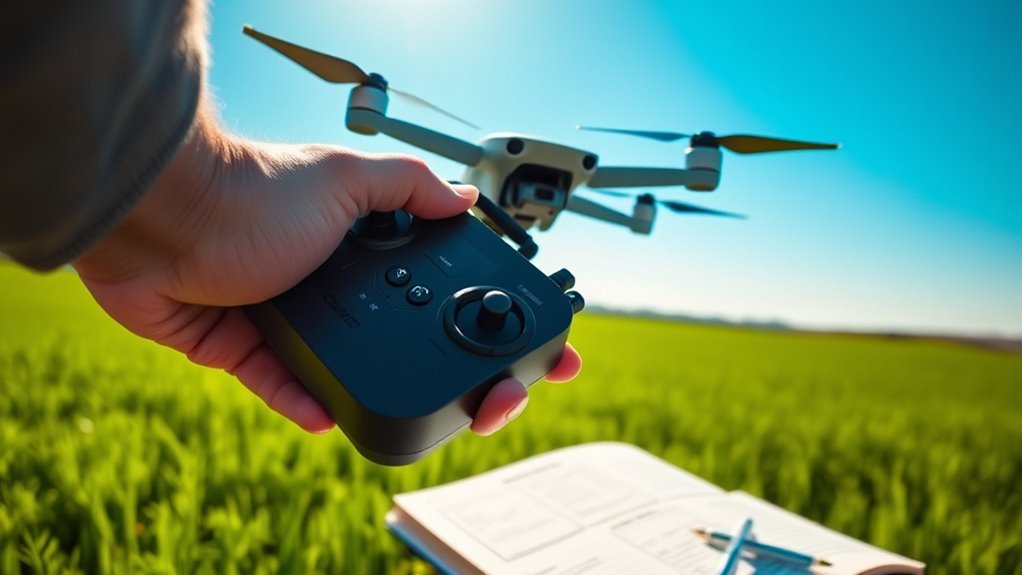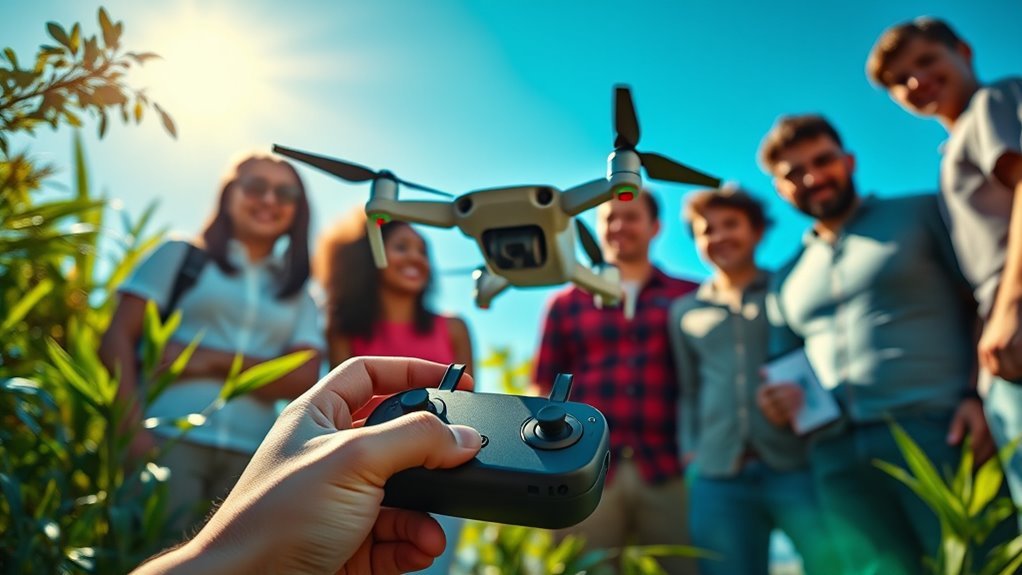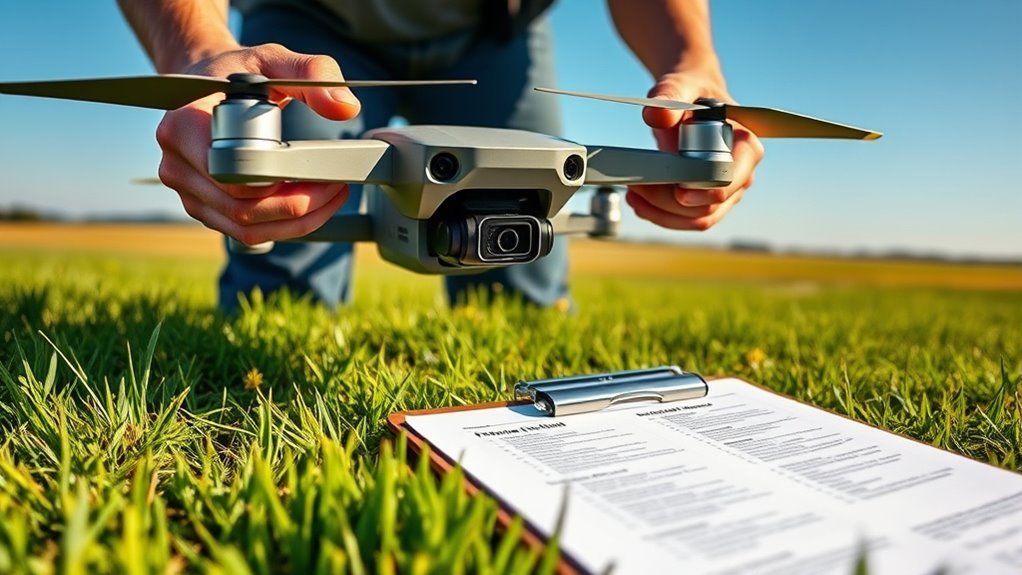To obtain a drone pilot license, start by understanding the requirements, including age and documentation. Next, choose a training course—either online or in-person. Study diligently for the FAA Knowledge Test and schedule it when you’re ready. After passing, complete the FAA Form 8710-13. Depending on your state, you might need a practical flight test. Finally, keep your license current by fulfilling renewal criteria and staying informed on regulations. Discover essential tips and resources to guide you further.
Understand the Requirements for a Drone Pilot License

Before you commence your journey to obtain a drone pilot license, it’s vital to understand the specific requirements set forth by regulatory bodies. First, familiarize yourself with the necessary regulatory compliance guidelines, which vary by country. These rules often include age restrictions, medical evaluations, and knowledge tests. You’ll need to grasp safety protocols that guarantee safe drone operation. Understanding airspace classifications and no-fly zones is essential to fly responsibly. Additionally, you may need to register your drone and obtain liability insurance. By mastering these requirements, you’re not just ticking boxes; you’re embracing the freedom that comes with being a licensed drone pilot, equipped to navigate the skies safely and legally. Your adventure awaits, but preparation is key!
Choose the Right Training Course

When choosing a training course for your drone pilot license, you’ll need to weigh the benefits of online versus in-person options. Each format offers unique advantages, so consider what best fits your learning style and schedule. Additionally, verify the course is accredited to guarantee you’re receiving quality instruction that meets industry standards.
Online vs. In-Person
Choosing between online and in-person training for your drone pilot license can considerably impact your learning experience. Both methods have their merits, and it’s essential to evaluate what fits your needs best.
Here are some factors to weigh:
- Flexibility: Online training allows you to learn at your pace and on your schedule.
- Hands-On Experience: In-person training offers practical flight sessions with instructors.
- Interactive Learning: Online courses can include forums or virtual classrooms for peer interaction.
- Cost-Effectiveness: Online training often comes at a lower price point.
- Personal Attention: In-person training provides direct feedback and guidance from instructors.
Ultimately, assess your learning style and goals to choose the right training course for you.
Course Accreditation Importance
Selecting a training course with proper accreditation can greatly impact your journey to obtaining a drone pilot license. When you choose a course recognized by reputable accreditation bodies, you’re ensuring a higher course quality. This means you’ll receive training that meets industry standards and prepares you for real-world scenarios. Accredited programs often provide thorough instruction on safety regulations, flight operations, and drone technology, all essential for your success. Plus, employers often look for candidates with certified training, giving you an edge in the job market. Don’t just settle for any course; prioritize accreditation to empower your skills and enhance your freedom as a drone pilot. Remember, your education plays a vital role in your future aerial adventures.
Study for the FAA Knowledge Test

Studying for the FAA Knowledge Test is a crucial step in obtaining your drone pilot license. To ace the exam, you’ll want to employ effective study techniques and familiarize yourself with the test materials. Here are some strategies that can help:
Studying for the FAA Knowledge Test is essential for earning your drone pilot license; effective techniques and test materials are key to success.
- Use online resources and practice exams to assess your knowledge.
- Join study groups or forums for collaborative learning and support.
- Create a study schedule to keep your preparation on track.
- Utilize flashcards for quick recall of important terms and concepts.
- Review the FAA’s official materials, including the Remote Pilot – Small Unmanned Aircraft Systems Study Guide.
Schedule and Pass the FAA Knowledge Test
Once you’re ready for the FAA Knowledge Test, you need to navigate the registration process. There are various study resources available to help you prepare effectively, so take advantage of them. Scheduling and passing this test is a critical step in obtaining your drone pilot license, so make sure you’re well-prepared.
Test Registration Process
Getting ready for the FAA Knowledge Test is an essential step in obtaining your drone pilot license. To streamline your test registration process, keep these test registration tips in mind:
- Choose the Right Testing Center: Find a location that fits your schedule.
- Register Early: Secure your spot to avoid last-minute stress.
- Review ID Requirements: Confirm you have the necessary identification ready.
- Prepare for the Exam Format: Familiarize yourself with the types of questions you’ll face.
- Practice with Sample Tests: Use practice exams to gauge your readiness and refine your test preparation strategies.
Study Resources Available
After completing the test registration process, it’s time to focus on effective study resources that can help you prepare for the FAA Knowledge Test. You’ll find a variety of study materials tailored to your learning style. Consider investing in online courses, which offer structured lessons and quizzes to reinforce your understanding of drone regulations, airspace classifications, and safety protocols. Many platforms also provide interactive simulations, helping you visualize complex concepts. Additionally, don’t overlook the value of FAA publications and practice exams, which are essential for familiarizing yourself with the test format. By utilizing these resources, you can boost your confidence and make certain you’re well-prepared to ace the FAA Knowledge Test and begin your drone piloting journey.
Complete the FAA Form 8710-13
Completing the FAA Form 8710-13 is an essential step in obtaining your drone pilot license. This form is vital in the application process and guarantees your form submission is accurate and complete. Here’s what you need to know:
- Gather personal information: You’ll need your name, address, and contact details.
- Provide flight experience: Document your relevant flight hours and training.
- Select your certification type: Choose between Part 107 for commercial use or other applicable categories.
- Review requirements: Verify you meet all prerequisites before submission.
- Submit electronically: Use the FAA’s online portal for a streamlined process.
Pass a Practical Flight Test
Once you’ve submitted the FAA Form 8710-13, the next step involves demonstrating your flying skills through a practical flight test. This test evaluates your ability to execute various practical flight techniques under realistic conditions. You’ll need to showcase maneuvers like takeoffs, landings, and emergency procedures while adhering to safety protocols.
To ace this test, effective test preparation strategies are essential. Familiarize yourself with your drone’s controls, practice maneuvers regularly, and consider mock tests to build your confidence. Understanding the flight environment and regulations will also enhance your performance. Remember, this is your chance to prove your competence and freedom to operate a drone safely. Embrace the challenge, and let your skills shine!
Keep Your License Up to Date
To guarantee your drone pilot license remains valid, it is crucial to stay informed about the FAA’s requirements and any regulatory changes that may arise. Keeping your license up to date involves a commitment to ongoing education and timely license renewal. Here are some steps to help you maintain your license:
- Monitor FAA updates: Regularly check for changes in drone regulations.
- Complete required training: Engage in ongoing education courses to enhance your skills.
- Schedule license renewal: Don’t let your license expire; renew it on time.
- Participate in community forums: Join discussions to stay connected with other pilots.
- Log your flight hours: Maintain a record of your experience for future references.
Frequently Asked Questions
How Long Does It Take to Get a Drone Pilot License?
So, you’re ready to soar the skies? Well, the training duration for a drone pilot license varies, but expect a few weeks to a couple of months for the licensing process. Freedom awaits—just don’t rush it!
What Is the Cost of Obtaining a Drone Pilot License?
Obtaining a drone pilot license involves drone training costs and licensing fees. Typically, you’ll spend between $200 and $2,000, depending on your training choice and additional expenses like study materials and exam fees.
Can I Fly My Drone Commercially Without a License?
Imagine soaring like a bird, but without proper drone regulations, you risk crashing into legal storms. Without a license, you can’t access commercial benefits, limiting your potential in the skies. Always fly wisely and legally.
Are There Age Restrictions for Obtaining a Drone Pilot License?
Yes, there’re age restrictions for obtaining a drone pilot license. You must be at least 16 years old for the minimum age requirement, and age verification is necessary during the application process. Enjoy your freedom responsibly!
What Medical Requirements Must I Meet to Become a Drone Pilot?
To become a drone pilot, you’ll need to pass medical evaluations confirming your fitness. Specifically, you must meet vision requirements, ensuring you can see clearly for safe and effective operation in the skies.

